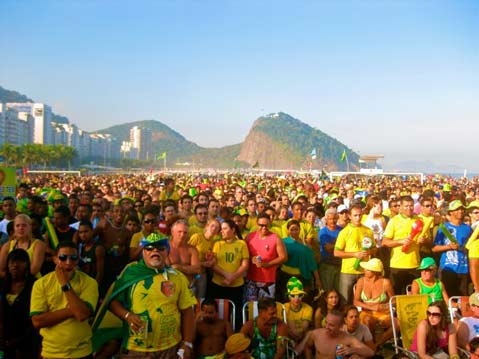The Copa do Mundo
From Laughter to Tears

“I don’t know what I like more, Carnaval or the World Cup,” said one drunken Carioca man about five hours after Brazil made it into the final 16 teams of the World Cup. Indeed, when Brazil lost last Friday, I found myself experiencing once again that post-Carnaval “What just happened” feeling.
But this was different. It’s terrible (or wonderful) how such a good thing can terminate (or intensify) so abruptly. The World Cup is a dauntingly dependent variable, whereas Carnaval is quite the independent variable. The sad afternoon that was Friday, July 2, would never have happened if this were Carnaval. The World Cup fiery frenzy that blanketed Brazil was extinguished with The Netherlands’ making a goal.
But before I let the defeated attitude of all of Rio bring me down, I’ve got to talk about the preceding months. After all, just because I waited until well after the Brazilian selection got back from South Africa to write this all out doesn’t mean I wasn’t going to talk about it. Like a good Brazilian, I banked on them winning this year. There wasn’t a doubt in any true Carioica’s mind that Brazil would take home the glorious golden World Cup trophy this July 11—for the sixth time!
While Carnaval is certainly culturally defining in Brazil, it lacks the nationalism of the World Cup. The wave of World Cup obsession first became heavily evident in May. Shops all over Rio ordered massive shipments of Brazil-themed clothing, costumes, decorations, and accessories. The fact that I painted my bike green, yellow, and blue because they were the only colors at the paint shop in early May fits right into World Cup supply and demand logic. Green, blue, and yellow streamers and miniature Brazilian flags were strung from building top to building top, creating little Brazilian tunnels on streets throughout Rio. By my old house, the sidewalk was even painted – the stones alternated the three colors along the long, windy road.
Quite contrary to Carnaval norms, which see people dressing in costumes in order to pretend they’re other people, the World Cup is all about Brazil pride. As May went on, people sported more and more Brazil futebol jerseys and t-shirts. This spring’s “in” fashion colors were yellow, green, and blue. On game days, anybody wearing anything other than green, yellow, and blue stands out. Apathetic, soulless traitors. So the nationalistic aspect of the World Cup turns the festivities into more of a team effort.
And then there’s the seriousness factor—or lack thereof. Here’s a fun fact: Brazil is the only nation in the world whose government takes an official break during the country’s World Cup games. That’s right, Brazil, with all of the socioeconomic and political problems it faces as a massive developing country with a severe social divide and corruption in every corner, simply stops for futebol.
Among other things that simply shut down during (or surrounding) Brazil Cup games are transportation, public services, educational facilities, and even many medical centers. Even the characteristically Brazilian late arrival is suspended—no one would dare miss a second of a game. One second missed could end up being the second that changed world history, after all. (Anyone who had to rely on replay to watch Zedane’s headbutt back in 2006 knows that.)
When game day is here, people from all over the world swarm to Copacabana beach. Rio is one of six lucky cities outside of South Africa where FIFA set up free game-viewing arenas. South Africa has nine, and others are in Sydney, Paris, Berlin, Rome, and Mexico City. Rio’s features a screen 50 square meters in size, which shows all the games to people who sit and stand in the sand. But for the Brazil games it’s necessary to show up early. Only the first 20,000 people get in.
The thousands that don’t fit into the FIFA Fun Fest are herded around the sides of the arena to another screen. The two are back to back, but the one outside doesn’t have walls or security, and has cheaper beer, and spectators are free to run into the ocean at halftime.
Brazilians who prefer a more laid-back atmosphere call up their friends and families, stock their fridges with beer, light up the grill, and host World Cup churascos (Brazilian barbeques) all day long. These are especially fun celebrations in the favelas, where churascos speckle the rooftops of hundreds of homes within a small area. Fireworks are also popular, and add loud booms to the collective cheers before, after, and during Brazil goals.
And then on Friday, July 2, Brazil lost to The Netherlands 2-1. The festive atmosphere that had blanketed the city for the last two months suddenly lunged to the opposite extreme. Dreams were crushed. Many people cried. Most were in disbelief. Still others fell into drunken stupors.
The next important order of business was making sure Argentina would lose. Sure enough, their total destruction at the hands (feet, rather) of Germany the next day was the miniscule positive counter to Brazil’s horrifying defeat. (Germany couldn’t have made us more proud – 4-0 in the quarter finals is nothing but embarrassing!)
And then Spain beat Paraguay, The Netherlands beat Uruguay, and the World Cup may as well have been over. Only European teams remained—none of the controversial ones (France, Italy, etc.)—and media coverage down here started to lag. It stopped focusing on the ongoing competition and instead continued to cover the mass depression nationwide in Brazil.
Brazil’s got four years now to recover. In 2014, Brazil will not only win the World Cup but they will do it on their own luscious, green turf!



